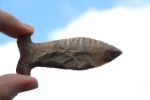A lot of beautiful arts and antiques from all over the world.
Large collection of swords, including Japanese Samurai swords.
|
ЛОТ 25J:
Flint Simpson mustache arrowhead point Neolithic or Paleolithic, Native American, 82 mm
далее...
|
|






|
Стартовая цена:
$
500
Эстимейт :
$10 000 - $20 000
Комиссия аукционного дома: 24%
Далее
|
Flint Simpson mustache arrowhead point Neolithic or Paleolithic, Native American, 82 mm
A masterpiece Neolithic/Paleolithic tool, which can be used as a knife, scraper, chopper, hand-axe, arrow head, spear head, etc. Length: 82 mm; Weight: 20.64 g; Mohs’ hardness: 9.0-9.5; Origin: North America, Florida; private collection in USA Flint was one of the most important materials in the Stone Age, used by people everywhere around the world. This raises at least one obvious question: why? What makes flint so special? Flint is a unique kind of rock. Like other forms of quartz, it's very hard and very durable. That's useful. After all, for all the effort it would take a nomadic people to create their tools, you don't want to waste resources or time. So, why not just use quartz? As a microcrystalline variety of quartz, flint has a unique molecular structure. There's a lot of science that we don't really need to discuss here, but what matters is that when you strike flint in just the right way, it breaks into uniform flakes with a very sharp edge. This is what made flint so valuable to ancient people. It was hard enough to be used time and again, but was also workable. They knew that if they took a large piece of flint and hit it with another rock or bone, it would break in predictable and controllable ways. Other kinds of rock would just shatter or splinter, making them impossible to craft into a useable tool. Flint is one of the best stones there is for creating a reliable tool, particularly if you need one with a sharp edge, and ancient people around the world discovered that. https://study.com/academy/lesson/stone-age-flint-tools.html Flint is a sedimentary cryptocrystalline form of the mineral quartz,[1][2] categorized as the variety of chert that occurs in chalk or marly limestone. Flint was widely used historically to make stone tools and start fires. It occurs chiefly as nodules and masses in sedimentary rocks, such as chalks and limestones.[3][4] Inside the nodule, flint is usually dark grey, black, green, white or brown in colour, and often has a glassy or waxy appearance. A thin layer on the outside of the nodules is usually different in colour, typically white and rough in texture. The nodules can often be found along streams and beaches. Flint breaks and chips into sharp-edged pieces, making it useful for knife blades and other cutting tools. The use of flint to make stone tools dates back millions of years, and flint's extreme durability has made it possible to accurately date its use over this time. Flint is one of the primary materials used to define the Stone Age. During the Stone Age, access to flint was so important for survival that people would travel or trade to obtain flint. Flint Ridge in Ohio was an important source of flint and Native Americans extracted the flint from hundreds of quarries along the ridge. This "Ohio Flint" was traded across the eastern United States and has been found as far west as the Rocky Mountains and south around the Gulf of Mexico.[5] When struck against steel, flint will produce enough sparks to ignite a fire with the correct tinder, or gunpowder used in weapons. Although it has been superseded in these uses by different processes (the percussion cap), or materials, (ferrocerium), "flint" has lent its name as generic term for a fire starter.


